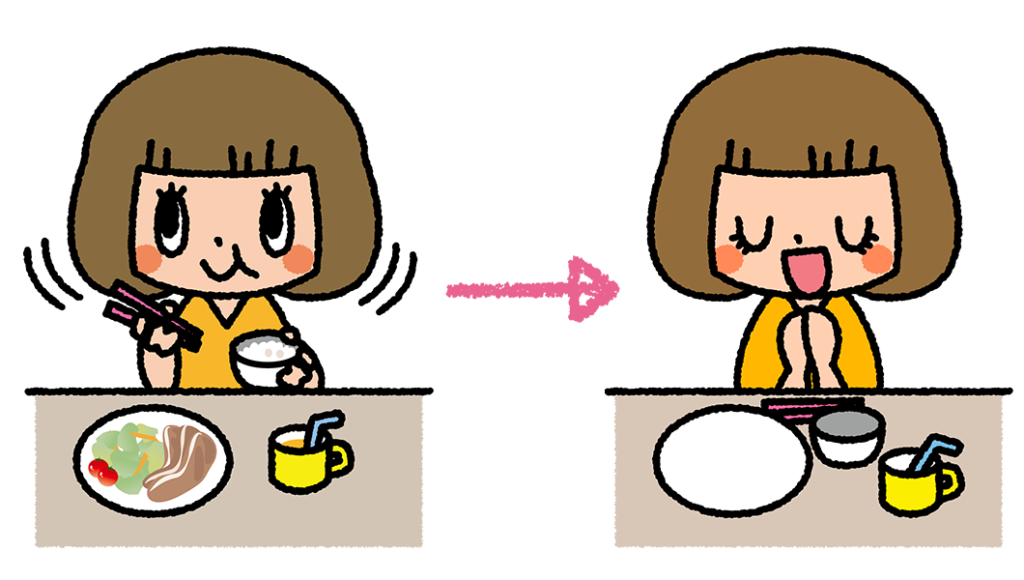28 June 2020
What is te-form and When to Use It?
(This article was reviewed and edited by native Japanese speakers to ensure accuracy.)
The te-form can be an extremely useful and versatile grammar form. It is characterized by the ending て(te) or で(de).
What can be particularly confusing about this form is that there are many different uses and conjugation rules. It’s used for connecting different phrases and adjectives, showing a series of actions, and making requests. Hopefully, this article can clear up any confusion!
How to conjugate verbs to te-form
The first step to using te-form is to figure out how to form it. With verbs, you can either look at the past tense form or the dictionary form to determine its te-form. One important thing is that the te-form does not have any tense by itself. The tense is determined by the final verb that follows.
Conjugating using the past tense form

If you already know how to form the past tense, I’d recommend this method.
A verb ending of だ(da) in the past tense is replaced by で(de).
飲んだ → 飲んで
nonda → nonde
Verbs which end in た(ta) in the past tense changes to て(te).
食べた → 食べて
tabeta → tabete
Conjugating using the dictionary form


The more complex way to figure out the te-form is to use the dictionary form. Here’s how it works:
Ru-verbs or vowel stem verbs ending in る(ru) (also known as group 2 or ichidan verbs) will have the ending replaced by て(te). Not all ru-verbs follow this rule so it’s important to know the different verb groups.
食べる → 食べて
taberu → tabete
There are two irregular verbs ending in る(ru): する(suru), meaning “to do”, and くる(kuru), meaning “to come”. They are conjugated as follows.
する → して
suru → shite
来る → 来て
kuru → kite
U-verbs which end in う(u), つ(tsu), and る(ru), also known as group 1 or godan verbs, change to って(tte).
売る → 売って
uru → utte
買う → 買って
kau → katte
立つ → 立って
tatsu → tatte
Verbs ending in く(ku) and ぐ(gu) change to いて(ite) and いで(ide) respectively.
焼く → 焼いて
yaku → yaite
泳ぐ → 泳いで
oyogu → oyoide
Verbs ending in ぬ(nu), ぶ(bu), and む(mu) change to んで(nde).
死ぬ → 死んで
shinu → shinde
学ぶ → 学んで
manabu → manande
飲む → 飲んで
nomu → nonde
Verbs with an ending of す(su) change to して(shite).
話す → 話して
hanasu → hanashite
How to conjugate adjectives to te-form
Adjectives can also be conjugated to te-form based on whether they are a な(na) or い(i) adjective. Na-adjectives are those that use な when describing something.
Examples include きれいな(kireina), 有名な(yuumeina), 小さな(chiisana). I-adjectives are those that end in い like 面白い(omoshiroi), 美味しい(oishii), or 美しい(utsukushii).
Na-adjectives change to で(de) and i-adjectives will change to くて(kute) in the te-form.
きれいな → きれいで
kireina → kireide
面白い → 面白くて
omoshiroi → omoshirokute
Negative te-form adjectives and verbs
Adjectives


There is only one form of the negative te-form of an adjective. It’s formed by taking the negative form of the adjective, dropping the ending い(i) and replacing it with くて(kute). For example:
na-adjective
きれいじゃない → きれいじゃなくて
kirei janai → kirei janakute
きれいではない → きれいではなくて
Kirei dewanai → kirei dewanakute
i-adjective
面白くない → 面白くなくて
omoshirokunai → omoshirokunakute
Verbs


These can have two forms, で(de) or くて(kute) in the negative te-form. で is used in situations where the te-form verb is connecting to another verb in a sentence pattern, or when making requests. They are formed by simply adding で to the negative form of the verb.
Here’s an example of how to form it:
歩かない → 歩かないで
arukanai → arukanaide
Here are some situational examples:
Connecting to another verb
走らないで運動しよう!
Hashiranai de undou shiyou!
Let’s exercise without running!
Making requests
走らないで!
Hashiranaide!
Don’t run!
くて(kute) typically connects verbs to adjectives and often implies a cause and effect. They are formed by dropping the い from the negative form of the verb and adding くて.
走らない → 走らなくて
hashiranai → hashiranakute
Situational examples:
Verb connecting to adjective
走らなくていい。
Hashiranakute ii.
You don’t have to run.
Cause and effect
勉強しなくて、先生に怒られた。
Benkyou shinakute, sensei ni okorareta.
I didn’t study so I was scolded by my teacher.
Using te-form verbs to connect sentence patterns
One of the primary uses of verbs in te-form is to connect to different sentence patterns. After creating the te-form with one verb, it can further connect to another verb or adjective.
An important thing to keep in mind is that all of these phrase endings also have a negative form. However, the negative form affects the verb in te-form, and not the ending verb. Here are some common ones:
~ている (te iru) and ~ていない (te inai)
This connects a verb to いる(iru), meaning “to be”. The negative form is 〜ていない. In English it is similar to the “ing” form. It expresses something that is continuously happening.
今、お昼食べている。
Ima, ohiru tabete iru.
I’m eating lunch right now.
今、お昼食べていない。
Ima, ohiru tabete inai.
I’m not eating lunch right now.
When forming these sentences, the い after て is often dropped so it is smoother.
今、お昼食べてる。
Ima, ohiru tabeteru.
I’m eating lunch right now.
今、お昼食べてない。
Ima, ohiru tabetenai.
I’m not eating lunch right now.
~てみる (te miru) and 〜てみない (te minai)
These two sentence patterns mean something like “to try”. The negative form is 〜てみない and can in certain cases means something similar to the positive form. Here are two examples:
宝くじ買ってみる?
Takarakuji katte miru?
Do you want to try buying a lottery ticket?
宝くじ買ってみない?
Takarakuji katte minai?
Why don’t we try buying a lottery ticket?
~ていく (te iku) and 〜ていかない (te ikanai)
This connects to the verb, いく(iku), which means “to go” and its negative form is 〜ていかない . The te-form verb that precedes the sentence ending is something you will or will not do before going.
ご飯作っていくよ。
Gohan tsukutte ikuyo.
I’ll make food before I go.
ご飯作っていかない。
Gohan tsukutte ikanai.
I won’t make food before I go.
~てくる (te kuru) and 〜てこない (te konai)
These sentence patterns connect to the verb くる(kuru), which means “to come”. However, it doesn’t really mean “to come” in this context, but more like “going” or “not going”. It also implies that you’ll come back to the original place after completing the action.
外で運動してくる。
Soto de undou shite kuru.
I’m going to run outside.
外で運動してこない。
Soto de undou shite konai.
I’m not going to run outside
〜てある(te aru) and 〜てない(te nai) to exist
This connects the verb ある(aru), meaning “to exist”, to the any te-form verb. In these contexts it means something like “have” and “have not”. It’s used when something has or hasn’t been done already.
In the first example sentence, 〜てある implies that the ice cream is still there and hasn’t been eaten yet.
アイスクリーム買ってある。
Aisukuriimu katte aru.
I’ve bought ice cream.
アイスクリーム買ってない。
Aisukuriimu katte nai.
I haven’t bought ice cream.
~ていい(te ii)
This is a unique sentence ending because it connects to an adjective. いい(ii) comes from the adjective 良い (yoi or ii). It means “it’s ok”. The negative form of this sentence ending is not commonly used because it sounds awkward.
お菓子買っていい?
Okashi katte ii?
Is it ok to buy sweets?
The negative te-form of the verb will typically use くて(kute) because it’s connecting to an adjective. However, it can also work with で(de)
お金、返さなくていいです。
Okane, kaesanakute ii desu.
It’s ok not to return the money.
お金、返さないでいいです。
Okane, kaesanaide ii desu.
It’s ok not to return the money.
Describes a series of action
The te-form can also be used when describing events that are unfolding. It can be used like the word “then” in English. It might seem strange to add “then” to every phrase in the sentence, but in Japanese it’s necessary to put the te-form to link them all together.
It’s important that all events or actions be listed chronologically. Also, the final phrase of the sentence is what determines the tense of the whole sentence.
今日は会社行って、帰りに服買って、晩ごはん食べてくる。
Kyou wa kaisha itte, kaeri ni fuku katte, ban gohan tabete kuru.
Today I will go to work, then buy clothes on the way back, and then I am going to eat dinner.
昨日、買い物行って服買ってきた。
Kinou, kaimono itte fuku katte kita.
Yesterday, I went shopping and then bought clothes.
Making a request
This is another common use of the te-form. Although te-form often links phrases together, in these situations it comes at the end of the sentence.
The informal version of making a request, can be made using the te-form verb at the end of the sentence.
早く学校に来て!
Hayaku gakkou ni kite!
Come to school quickly!
やめてよ!
Yamete yo!
Stop it!
To make it formal, you can add ください (kudasai) at the end. However, it’s important to know that this can still sound demanding and strong.
早く学校に来てください!
Hayaku gakkou ni kite kudasai!
Please come to school quickly!
As a reminder, in the negative te-form of a verb, always use で (de).
こっち来ないで!
Kocchi konaide!
Don’t come here!
こっち来ないでください!
Kocchi konaide kudasai!
Please don’t come here!
触らないで!
Sawaranaide!
Don’t touch!
触らないでください!
Sawaranaide kudasai!
Please don’t touch!
In polite situations, you may want to ask for something in a softer way. You can use the verbs もらう(morau) or いただく(itadaku). Both verbs mean something like “to recieve”, but it’s like adding “could” or “would” in English.
明日学校に来てもらえませんか?
Ashita gakkou ni kite moraemasen ka?
Could you come to school tomorrow?
明日学校に来ていただけませんか?
Ashita gakkou ni kite itadakemasen ka?
Could you come to school tomorrow?
明日学校に来てもらえると嬉しいんですけど。
Ashita gakkou ni kite moraeruto ureshiin desu kedo.
It would be nice if you could come to school tomorrow.
明日学校に来ていただけると嬉しいんですけど。
Ashita gakkou ni kite itadakeruto ureshiin desu kedo.
It would be nice if you could come to school tomorrow.
Adjectives
Te-form adjectives are used to connect to both adjectives and verbs.
Adjectives connecting to verbs will usually have a cause and effect pattern. It is similar to “so” in English.
テスト、難しくて落ちた。
Tesuto, muzukashikute ochita.
The test was hard so I failed.
It can also link adjectives together, acting like the “and” in English. However, unlike “and” it needs to be used with every adjective until the last adjective.
夜は暗くて怖い。
Yoru wa kurakute kowai.
The night is dark and scary.
鈴木さんは背が高くて、頭が良くて、面白い人です。
Suzuki-san wa se ga takakute, atama ga yokute, omoshiroi hito desu.
Suzuki-san is a tall, smart, and interesting person.
Many Japanese learners can confuse と(to) which links together objects. In this case, make sure not to write: 夜は暗いと怖い (incorrect)
Advice for learning and using te-form
Since there are many uses and conjugations for te-form, it can be difficult to learn. It can be a good start to use the guidelines and rules, but eventually, it might be better to memorize conjugations separately from the rules. Another tip would be to observe the te-form in written text and when listening to Japanese. This could help you to be more intuitive when figuring out how to form the phrases themselves.

